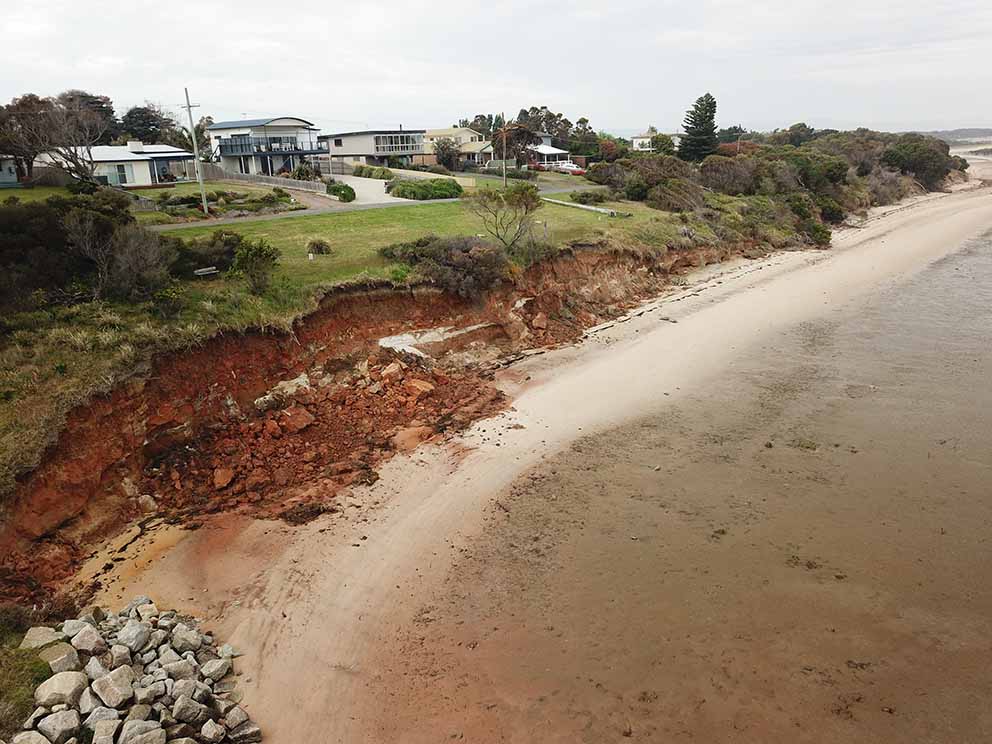By Geoff Ellis
TONY Laughton was fairly confident his home wasn’t going to topple over the Jam Jerrup cliff and into the water. But there were some nervous moments over the years as he watched the gap shrink between the house and cliff.
In the late 1980s the road to Jam Jerrup started to collapse into Western Port. Local authorities battled Mother Nature until ’91 when they abandoned that coastal road and scythed a new entranceway from the Bass Highway. What’s left of the original road is now the Jam Jerrup cliff walk. It still links the Lang Lang caravan park with Jam Jerrup but it’s a bit narrow in parts. At low tide walkers can use the sandy beach for a return loop.
TONY Laughton was fairly confident his home wasn’t going to topple over the Jam Jerrup cliff and into the water. But there were some nervous moments over the years as he watched the gap shrink between the house and cliff.
In the late 1980s the road to Jam Jerrup started to collapse into Western Port. Local authorities battled Mother Nature until ’91 when they abandoned that coastal road and scythed a new entranceway from the Bass Highway. What’s left of the original road is now the Jam Jerrup cliff walk. It still links the Lang Lang caravan park with Jam Jerrup but it’s a bit narrow in parts. At low tide walkers can use the sandy beach for a return loop.
Erosion is relentless along our coastline. Just over a decade ago, the Department of Environment, Land, Water and Planning (DELWP) installed a seawall along part of the Jam Jerrup foreshore. At the time the concrete sea wall in Grantville was falling over after being overwhelmed. Rock seemed a better option so that's what they used in Jam Jerrup. Groynes were then anchored between the end of the rock and mangroves that protect the shoreline toward Stockyard Point.
This was a bit of a science experiment but the waters and mud flats of Western Port are a complex system and a long term solution was needed to prevent the tides that sweep in from the port at Hastings from claiming the village. Many years later the results are now evident. The rock worked. Behind it the dune has returned along with native vegetation. That length of Jam Jerrup is safely protected.
All good, except that erosion was accelerating where the wall ends and the unprotected foreshore is disappearing fast. History was about to repeat and in 2019 it was calculated that the power lines and the road would fall within two years. The obvious solution was to extend the rock but the budget was spent long ago. Over the last several years Tony Laughton, first as a member and then president of the local foreshore committee, has led his community’s struggle against Mother Nature and Treasury.
This was a bit of a science experiment but the waters and mud flats of Western Port are a complex system and a long term solution was needed to prevent the tides that sweep in from the port at Hastings from claiming the village. Many years later the results are now evident. The rock worked. Behind it the dune has returned along with native vegetation. That length of Jam Jerrup is safely protected.
All good, except that erosion was accelerating where the wall ends and the unprotected foreshore is disappearing fast. History was about to repeat and in 2019 it was calculated that the power lines and the road would fall within two years. The obvious solution was to extend the rock but the budget was spent long ago. Over the last several years Tony Laughton, first as a member and then president of the local foreshore committee, has led his community’s struggle against Mother Nature and Treasury.
They pursued every angle and cajoled every authority. Grants weren’t forthcoming so there was talk of special charge schemes, environmental levels, crowd funding, perhaps even a rate strike but the clock was ticking. During those years of lobbying all and sundry it became apparent to Tony that they needed to take the lead. As talk grew of abandoning the road and creating yet another new road through Jam Jerrup, the foreshore committee paid their own consultants to design the rest of the wall and then work out how to fund it. This sent a strong message that Jam Jerrup was serious.
As the scouring worsened and the destruction increased, their images and drone footage provided textbook evidence of what happens due to wave energy at the end of rock walls. Late last year, as news spread of the imminent catastrophe, Tony organised an on-site meeting of all the major stakeholders. The evidence was there for everyone to see. Hundreds of metres of the foreshore were strewn with rocks and lumps of vegetation. Bits of the cliff were falling as representatives of council, state government and DELWP looked on.
This was a pivotal moment. Tony knew they couldn’t abandon this part of the road although the accountability was as clear as the Western Port mud flats. Council has a legal obligation to provide access to houses. Another road would be a costly option. AusNet needs to preserve its poles and wires and DELWP is responsible for the foreshore. The conversation intensified, though lack of money was the full stop.
On Monday, Tony was preparing for the next step when his phone rang. Spring Street calling! Bass MP Jordan Crugnale told Tony the ink was drying on a cheque for half a million dollars. A geotechnical study of the foreshore was about to begin. The photo of Tony on the foreshore best shows his reaction. Joy and relief are understatements for how he felt.
So here’s the plan, according to Ms Crugnale: The geotechnical investigation will determine the stability of the cliff which then informs the appropriate treatment, which may be a combination of natural and built infrastructure in a localised, tailored solution.
Translation: a rock wall of varying width, with sand infill between it and the cliff, along the length of the beach ending in the mangroves so the wave energy will be dissipated instead of forming a destructive scour.
In a Facebook post, Ms Crugnale praised “Jam Jerruppians who have been advocating quietly and strongly for a solution – great work and also DELWP’s Gippsland staff and their coastal experts for all their amazing work and the support of local councillors”.
All they have to do now is build it. Tony and the foreshore committee can return their attention to upgrading the caravan park that is the committee’s source of revenue. He wants to thank everyone, especially Bill Storer from DELWP who crossed Gippsland many times and refused to give up, even when the lack of funding made it look like history would repeat.
As the scouring worsened and the destruction increased, their images and drone footage provided textbook evidence of what happens due to wave energy at the end of rock walls. Late last year, as news spread of the imminent catastrophe, Tony organised an on-site meeting of all the major stakeholders. The evidence was there for everyone to see. Hundreds of metres of the foreshore were strewn with rocks and lumps of vegetation. Bits of the cliff were falling as representatives of council, state government and DELWP looked on.
This was a pivotal moment. Tony knew they couldn’t abandon this part of the road although the accountability was as clear as the Western Port mud flats. Council has a legal obligation to provide access to houses. Another road would be a costly option. AusNet needs to preserve its poles and wires and DELWP is responsible for the foreshore. The conversation intensified, though lack of money was the full stop.
On Monday, Tony was preparing for the next step when his phone rang. Spring Street calling! Bass MP Jordan Crugnale told Tony the ink was drying on a cheque for half a million dollars. A geotechnical study of the foreshore was about to begin. The photo of Tony on the foreshore best shows his reaction. Joy and relief are understatements for how he felt.
So here’s the plan, according to Ms Crugnale: The geotechnical investigation will determine the stability of the cliff which then informs the appropriate treatment, which may be a combination of natural and built infrastructure in a localised, tailored solution.
Translation: a rock wall of varying width, with sand infill between it and the cliff, along the length of the beach ending in the mangroves so the wave energy will be dissipated instead of forming a destructive scour.
In a Facebook post, Ms Crugnale praised “Jam Jerruppians who have been advocating quietly and strongly for a solution – great work and also DELWP’s Gippsland staff and their coastal experts for all their amazing work and the support of local councillors”.
All they have to do now is build it. Tony and the foreshore committee can return their attention to upgrading the caravan park that is the committee’s source of revenue. He wants to thank everyone, especially Bill Storer from DELWP who crossed Gippsland many times and refused to give up, even when the lack of funding made it look like history would repeat.

